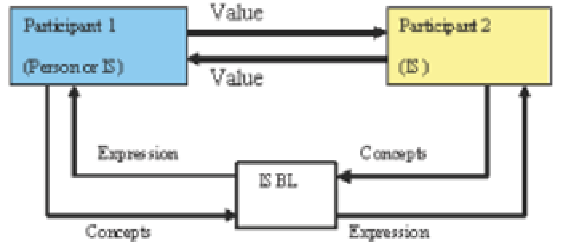Information Technology Reference
In-Depth Information
Figure 15.1. Business transaction mediated by the ISBL.
Figure 15.1 shows a standard type of transaction proceeding in parallel at two generic
levels. At the action level, it involves an exchange of values, for example the provision
of cash in return for the right to debit a bank account. At the second level, the exchange
of information supports and enables the completion of first level action. It is axiomatic
that genuine communication can only occur on the basis of shared understandings
(Gibbs, 1999); in this situation the shared understandings are represented in terminology
sourced from the language the participants have in common, conceptualised here as the
ISBL.
Permitted interactions are of course tightly scripted by the designers of autonomous
systems. An ATM will, for example, work according to a fully defined job description
(Dos Santos and Peffers, 1995), but must have the authorisation, the basic intelligence,
and the conversational competence to complete transactions on behalf of the organisa-
tion(s) represented. That the level of transactional complexity is low is essentially irrel-
evant to the argument being developed; the practical implication of an effective interac-
tion is that two entities acting autonomously have been able to communicate successfully.
The linguistic foundations will in practice usually be sufficiently unproblematic to stay
below the threshold of attention, but they can become salient under conditions of
breakdown. Thus, for example, the lack of conversational repair mechanisms when
dealing with an ATM quickly become apparent when it returns an incorrect amount of
money or refuses to recognise a credit card.
Propositions
The following lists twelve theoretical propositions that are discussed as a group in sub-
sequent sections. The propositions are framed in descriptive terms as topics susceptible
to empirical research. It is important to note that they were developed on the assumption
that a positive perspective on the ISBL is embedded in current thinking about systems
and standardisation. The view that autonomous IS provide great benefits of convenience
to consumers is not contested, and it is in fact impossible to see how the ever increasing
volumes of business transactions could be effectively handled without them (Weizen-
baum, 1984, p. 28). The argument is, however, that the increasing spread of ISBL-medi-
ated activity creates possibilities for the exercise of power and the exploitation of con-
sumers that warrant empirical research.
The propositions are as follows:
1.
Autonomous IS have been installed as organisational agents.
2.
The business behaviour of autonomous IS can be analysed in linguistic terms.

Search WWH ::

Custom Search